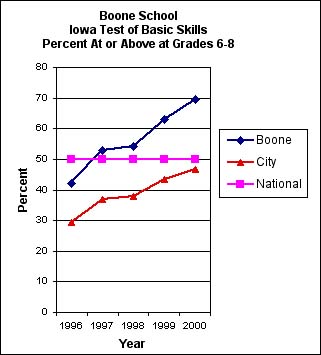 |
|
|
Poster Presentation Full Text: Can every child learn mathematics? What would it take to achieve it? Poster presentations are composed in four parts:
|
|
ALM's vision was one of systemic change, a transformation of whole-school systems into "learning organizations" that adopted new educational procedures (Senge, 1991).
We envisioned a district administration that (1) supported and valued the efforts of school personnel to improve instruction, and (2) used the media to inform the community about the purposes and support for the change efforts.
We envisioned schools that placed a priority on children's learning and understanding of mathematics. This priority would be apparent to visitors as they walked through every hallway and classroom.
We envisioned administrators who understood and supported Standards-based teaching. We knew the administrator would be the key to the success or failure of the change initiative. The administrator would make essential decisions such as: Do I treat teachers as professionals and involve them in the change process from the beginning? Do I provide time for professional development and in-class support? Do I have a visible presence in the classrooms to communicate the importance of the program and to ensure that improvements are taking place? Do I insist that the necessary materials are ordered and in the school before the first day of school? Do I schedule an hour a day for mathematics instruction? Do I adjust the schedule to support collegial interaction during the school day? Do I allocate time to meet with other principals to share experiences, successes and stumbling blocks?
We envisioned teachers who were interested in developing their own understanding of mathematics content and pedagogy. Teachers would be excited about participating in the project and would welcome the opportunity to attend professional development. Teachers would collaborate with colleagues. Supported by ALM program associates, teachers would begin to teach Standards-based lessons. They would encourage students' strategies and ideas, and respect students' thinking. Teachers would create assessments that would communicate to children that their mathematical ideas were valued. By the fourth year, teachers would be ready for a full implementation of a Standards-based curriculum without the assistance of a more experienced other.
Students would be eager to experience and learn mathematics. They would take responsibility for their own learning, initiate investigations, invent strategies for solving problems, and support the learning of their classmates.
After ALM support concluded, we expected administrators to take the necessary steps to continue the program. The administrators would continue to provide professional development opportunities for new teachers, either in the building or by sending them to ongoing UIC sessions. Administrators would either allocate funds to have a mathematics coordinator on staff, or release teacher-leaders to mentor new teachers and provide in-class support. Teachers would continue to use the curriculum and continue to interact with colleagues. They would observe each other's lessons and provide feedback, and be open to observers in their own classrooms. They might consider being teacher-researchers, and exploring ideas and issues in greater depth.
( BACK TO POSTER | BACK TO TOP )
We have witnessed the vision in some schools, but not in others. We know it is possible, but key elements must be in place.

( BACK TO POSTER | BACK TO TOP )
Year One - Pre-implementation, planning and professional development.
Years Two-Four - Professional development and classroom support.
Year Five - Professional development and classroom support for new teachers.
( BACK TO POSTER | BACK TO TOP )
THIS POSTER WAS PREPARED BY:
Kathryn Chval and Mary Jo Tavormina-Porn of the University of Illinois
at Chicago-All Learn Mathematics Project.
( BACK TO POSTER | BACK TO TOP )
|